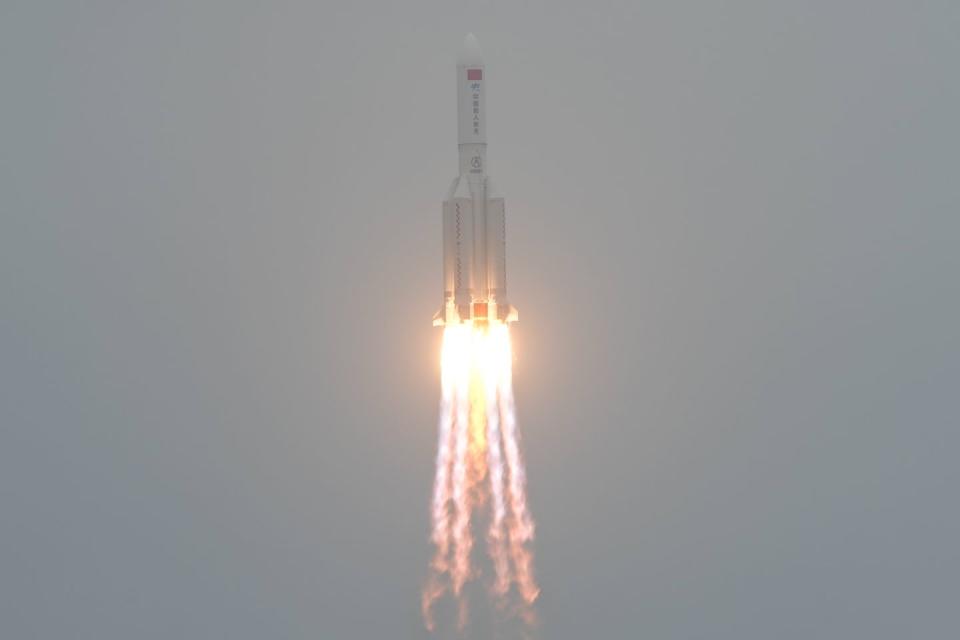A Chinese Rocket Is Wildly Careening Toward Earth This Weekend

U.S. Space Command is monitoring debris from the recent launch of a Chinese rocket.
The space junk is set to fall to Earth this weekend, and could even land on New York City.
China has a spotty track record of hazardous space debris.
U.S. Space Command is closely monitoring debris from a Chinese rocket that’s on a rapid collision course with Earth and projected to crash down sometime this weekend.
The debris, left over from the recent launch of a Chinese Space Station (CSS) module, could possibly land somewhere in the U.S., including cities like Los Angeles or New York City. While the event shouldn’t be hazardous, the military is still keeping an eye on the space junk just in case.
“We have the capability to do a lot of things, but we don’t have a plan to shoot it down as we speak,” U.S. Secretary of Defense Lloyd Austin told reporters on Thursday. “We’re hopeful that it will land in a place where it won’t harm anyone. Hopefully in the ocean, or someplace like that.”
The junk is actually the core launch stage from a Chinese CZ-5B “Long March” rocket. The CZ-5B, which launched on April 29, boosted the Tianhe-1 (“Harmony of the Heavens”) Chinese Space Station (CSS) module into orbit. At least two other science modules, the Wentian (“Quest for the heavens”) and Mengtian (“Dreaming of the heavens”), will eventually join the Tianhe-1 to form the CSS.

After the CZ-5B took off from the Wenchang Spacecraft Launch Site on Hainan island, just north of the South China Sea, most of the rocket debris was projected to land in the sea. The CZ-5B core stage, however, burned all the way to orbit; now, amateur space watcher Marco Langbroek says the stage is in a 375 x 170-kilometer orbit. The stage is set to reenter Earth’s atmosphere during a 30-hour window this weekend.
This isn’t some small piece of space junk we’re talking about. The CZ-5B is 100 feet long and 16 feet wide, with a dry mass between 17 and 22 tons, according to Langbroek’s estimates. U.S. Space Command, which has designated the core stage as NORAD catalog number 48275, estimates it will come down sometime on Saturday, May 8, though it could be as late as Sunday, May 9.
The landing site is also a problem. Large sections of a rocket routinely de-orbit over oceans to avoid hitting land. But this didn’t happen with the first launch of the CZ-5B last year, nor did it happen with the most recent launch. Although most of the 2020 debris fell back to Earth unnoticed, at least one piece landed with a bang in the village of Mahounou in the west African nation of Cote d’Ivoire. Fortunately, no one was injured.
There’s a remote possibility the CZ-5B debris will land on or near a populated area. The re-entry track at Langbroek’s site covers at least half of the globe, and most of the continental U.S. is within the potential landing zone. U.S. Space Command will eventually be able to narrow its projection for the landing area, but it won’t be until hours before the actual event, according to Stars and Stripes.
China doesn’t exactly have a sterling safety record with rocket launches. Rocket debris, including hazardous chemicals, frequently falls back to land in China—occasionally hitting populated areas. Two such incidents took place in April and November 2019, and a 2002 event resulted in minor injuries to a young boy. In 1996, a rocket malfunction at Xichang officially killed six people, though the true death total may have been much higher.
?? Now Watch This:
You Might Also Like